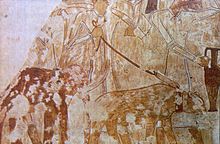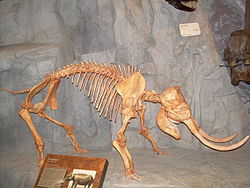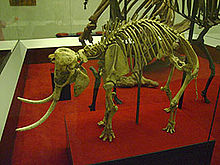- Dwarf elephant
-
Dwarf elephants
Temporal range: PleistoceneDwarf Elephas skeleton cast Scientific classification Kingdom: Animalia Phylum: Chordata Class: Mammalia Order: Proboscidea
in partDwarf elephants are prehistoric members of the order Proboscidea, that, through the process of allopatric speciation, evolved to a fraction of the size of their immediate ancestors. Insular dwarfism is a biological phenomenon by which the size of animals isolated on an island shrinks dramatically over time for the smaller animals have survived because of the underabundance of food.
Fossil remains of dwarf elephants have been found on the Mediterranean islands of Cyprus, Malta (at Ghar Dalam), Crete, Sicily, Sardinia, the Cyclades Islands and the Dodecanese Islands. Other islands where dwarf elephants have been found are Sulawesi, Flores, Timor and other islands of the Lesser Sundas. The Channel Islands of California once supported a dwarf species descended from Columbian mammoths,[1] while small races of woolly mammoths were once found on Wrangel Island and Saint Paul Island.
Contents
Mediterranean Islands
Dwarf elephants were, after the Messinian salinity crisis, part of the Pleistocene fauna of all the larger Mediterranean islands, with the apparent exception of Corsica and the Balearics. Mediterranean dwarf elephants have generally been considered as paleoloxodontine, derived from the continental Straight-tusked Elephant, Elephas (Palaeoloxodon) antiquus Falconer & Cautley, 1847. An exception is the dwarf Sardinian Mammoth, Mammuthus lamarmorae (Major, 1883), the only endemic elephant of the Mediterranean islands belonging to the mammoth line. A DNA research published in 2006 theorized that the Elephas creticus could be from the mammoth line too. This old theory, proposed by Dorothea Bate as early as 1905, is not widely accepted. A scientific study of 2007 demonstrates the mistakes of the DNA research of 2006.[2]
During low sea levels, the Mediterranean islands were colonised again and again, giving rise, sometimes on the same island, to several species (or subspecies) of different body sizes. These endemic dwarf elephants were taxonomically different on each island or group of very close islands, like the Cyclades archipelago.
There are many uncertainties about the time of colonisation, the phylogenetic relationships and the taxonomic status of dwarf elephants on the Mediterranean islands. Extinction of the insular dwarf elephants has not been correlated with the arrival in the islands of man. Furthermore, it has been suggested by the paleontologist Othenio Abel in 1914,[3] that the finding of skeletons of such elephants sparked the idea that they belonged to giant cyclopses, because the center nasal opening was thought to be a cyclopic eye socket.
Sardinia
- Mammuthus lamarmorae (Major, 1883)
- Elephas (Palaeoloxodon) antiquus (Acconci, 1881)
- Elephas (Palaeoloxodon) melitensis Falconer, 1868
Sicily & Malta
- Elephas (Palaeoloxodon) antiquus leonardii Aguirre, 1969
- Elephas (Palaeoloxodon) mnaidriensis (Adams, 1874)
- Elephas (Palaeoloxodon) melitensis Falconer, 1868
- Elephas (Palaeoloxodon) falconeri Busk, 1867
Crete
- Elephas (Palaeoloxodon) creticus (Bate, 1907)
- Elephas (Palaeoloxodon) creutzburgi (Kuss, 1965)
- Elephas (Palaeoloxodon) chaniensis (Symeonides et al., 2001)[4]
After DNA research, published in 2006, it has been proposed to rename Elephas (Palaeoloxodon) creticus into Mammuthus creticus (Bate, 1907). Others proposed (in 2002[citation needed]) to rename all the described specimens of larger size under the new subspecies name Elephas antiquus creutzburgi (Kuss, 1965). In a recent study of 2007, it was argued for the groundlessness of the theory by Poulakakis et al. in 2006,[5] showing the weak points of that DNA research.[2]
Cyprus
- Elephas (Palaeoloxodon) cypriotes Bate, 1903
The Cyprus dwarf elephant survived at least until 11,000 BP. Its estimated body weight was only 200 kg, only 2% of its 10,000 kg ancestor. Molars of this dwarf are reduced to approximately 40% the size of mainland straight-tusked elephants.
Remains of the species were first discovered and recorded by Dorothea Bate in a cave in the Kyrenia hills of Cyprus in 1902 and reported in 1903.[6][7]
Cyclades Islands
Remains of paleoloxodontine elephants have been reported from the islands of Delos, Naxos, Kythnos, Serifos and Milos. The Delos elephant is of similar size to a small Elephas antiquus, while the Naxos elephant is of similar size to Elephas melitensis. The remains from Kythnos, Serifos and Milos have not been described.
Dodecanese Islands
On the island of Rhodes, bones of an endemic dwarf elephant have been discovered. This elephant was similar in size to Elephas mnaidriensis.
Two groups of remains of dwarf elephants have been found on the island of Tilos. They are similar in size to Elephas mnaidriensis and the smaller Elephas falconeri, but the two groups indicate sexual dimorphism.[8][9] The remains had originally been designated to Palaeoloxodon antiquus falconeri (Busk, 1867). However, this name refers to the dwarf elephants from the island of Malta. As a result, since no migration route between the two islands can be proved, this name should not be used when referring to the elephant remnants from Tilos, although some scientists have accepted the temporary use of this name until further material can be examined.[8].
File:Tilos museum.jpgThe new building of the Palaontology Museum on Tilos IslandFile:Elephas tiliensis.jpgCurrent Exhibition of an Elephas tiliensisThe Tilos dwarf elephant is the first dwarf elephant whose DNA sequence has been studied. The results of this research are consistent with previous morphological reports, according to which Palaeoloxodon is more closely related to Elephas than to Loxodonta or Mammuthus. After the study of new osteological material <Theodorou et al. 2007> that has been excavated in anatomical connection in the Charkadio Cave on Tilos island the new species name Elephas tiliensis has been assigned to the Tilos dwarf elephants. It was the latest paleoloxodontine to survive in Europe. They became extinct just less than 4,000 years BP, so this elephant survived well into the Holocene. A exhibition is available at the Municipality of Tilos Island, soon to be transferred to the new building near Charkadio Cave.
Currently there is a proposed project named MECHANIMAL - under evaluation - that if accepted will be founded by the Greek Ministry of Education. MechAnimal Project
Channel Islands of California
The Columbian mammoth (Mammuthus columbii) produced a separate, isolated population at the end of the Pleistocene. One of these isolated groups was formed on the Channel Islands of California, most likely about 40,000 years ago (although the time of isolation is not fully known). Selective forces on the Channel Islands resulted in smaller animals, forming a new species, the Pygmy Mammoth Mammuthus exilis. Channel Islands mammoths ranged from 150–190 cm in shoulder height.
Wrangel Island
 Detail of a painting in the tomb of Rekhmire in Egypt, believed by some to depict a "pygmy mammoth" (lower left) among other animals
Detail of a painting in the tomb of Rekhmire in Egypt, believed by some to depict a "pygmy mammoth" (lower left) among other animals
During the last ice age, woolly mammoths (Mammuthus primigenius) lived on Wrangel Island in the Arctic Ocean. It has been shown that mammoths survived on Wrangel Island until 1700 BCE, the most recent survival of any known mammoth population. They also survived on Saint Paul Island in the Bering Sea until 6000 BCE.[10] Wrangel Island is thought to have become separated from the mainland by 12,000 years BP. Survival of a mammoth population may be explained by local geographic, topographic and climatic features, which entailed preservation of communities of steppe plants, as well as a degree of isolation sufficient to delay colonization by humans. St. Paul Island shares this characteristic of geographic isolation, implying that human hunting played a role in the disappearance of the woolly mammoth. Wrangel Island mammoths ranged from 180–230 cm in shoulder height and were for a time considered "dwarf mammoths".[11] However this classification has been re-evaluated and since the Second International Mammoth Conference in 1999, these mammoths are no longer considered to be true "dwarf mammoths".
Indonesia
On Sulawesi and Flores evidence of a succession of distinct endemic island faunas has been found, including dwarfed elephants, dating until the Middle Pleistocene. Around the early Middle Pleistocene these dwarfed elephants were replaced by new immigrants of larger to intermediate sizes.
Flores
The present understanding of the succession of Stegodon species on Flores is that endemic dwarfs, represented by the Early Pleistocene species Stegodon sondaarii, became extinct around 840,000 years ago. These dwarf forms were then replaced by the medium to large-sized Stegodon florensis, a species closely related to the Stegodon trigonocephalus group found both in Java and in the islands of biogeographical Wallacea, separated by deep water from the Asian and Australian continental shelves. This Stegodon species went extinct about 12,000 years ago, presumably because of a volcanic eruption.
Sulawesi
The dwarfed Stegodon sompoensis lived during the Pleistocene on the island of Sulawesi. They had a shoulder height of only 1.5m.
See also
References
- ^ "PYGMY MAMMOTH UPDATE". http://www.nps.gov/archive/chis/pygmy.htm.
- ^ a b Orlando, L., Pagés, M., Calvignac, S., et al. (2007-02-22). "Does the 43bp sequence from an 800000 year old Cretan dwarf elephantid really rewrite the textbook on mammoths?". Biology Letters 3 (1): 57–59. doi:10.1098/rsbl.2006.0536.
- ^ Abel's surmise is noted by Adrienne Mayor, The First Fossil Hunters: Paleontology in Greek and Roman Times (Princeton University Press) 2000.
- ^ Symeonides, N. K.; et al. (2001). "New data on Elephas chaniensis (Vamos cave, Chania, Crete)". In Cavarretta, Giuseppe (ed.), The World of Elephants - International Congress, Rome 2001, Rome 2001, 510-513. ISBN 88-8080-025-6
- ^ Poulakakis N., Parmakelis A., Lymberakis P., Mylonas M., Zouros E., Reese D., Glaberman S., Caccone A. (2006). "Ancient DNA forces reconsideration of evolutionary history of Mediterranean pygmy elephantids". Biol. Lett. 2 (3): 451–454. doi:10.1098/rsbl.2006.0467. PMC 1686204. PMID 17148428. http://www.pubmedcentral.nih.gov/articlerender.fcgi?tool=pmcentrez&artid=1686204.
- ^ Bate, D. M. A.: Preliminary Note on the Discovery of a Pigmy Elephant in the Pleistocene of Cyprus in Proceedings of the Royal Society of London Vol. 71 (1902 - 1903), pp. 498-500
- ^ Dorothea Bate, Cyprus work diary 1901–02, 3 volumes, Natural History Museum's earth sciences library, palaeontology MSS
- ^ a b Theodorou, G. (1983). The dwarf elephants of the Charkadio cave on the island of Tilos (Dodekanese, Greece). Phd Thesis Athens University. p. 321 pp.
- ^ Theodorou, G.E. (1988). "Environmental factors affecting the evolution of islands endemics: The Tilos example for Greece". Modern Geology 13: 183–188.
- ^ Guthrie, R. Dale (2004-06-17). "Radiocarbon evidence of mid-Holocene mammoths stranded on an Alaskan Bering Sea island". Nature (Nature Publishing Group) 429 (6993): 746–749. doi:10.1038/nature02612. PMID 15201907. http://www.nature.com/nature/journal/v429/n6993/abs/nature02612.html. Retrieved 2008-12-02.
- ^ Vartanyan, S.L., Garutt, V.E., Sher, A.V. (1993). "Holocene dwarf mammoths from Wrangel Island in the Siberian Arctic". Nature 362 (6418): 337–340. doi:10.1038/362337a0.
Categories:- Prehistoric elephants
- Holocene extinctions
- History of Sardinia
- History of Sicily
- History of Malta
- Prehistoric Crete
- Prehistoric Cyprus
- Cyclades
- Dodecanese
Wikimedia Foundation. 2010.




